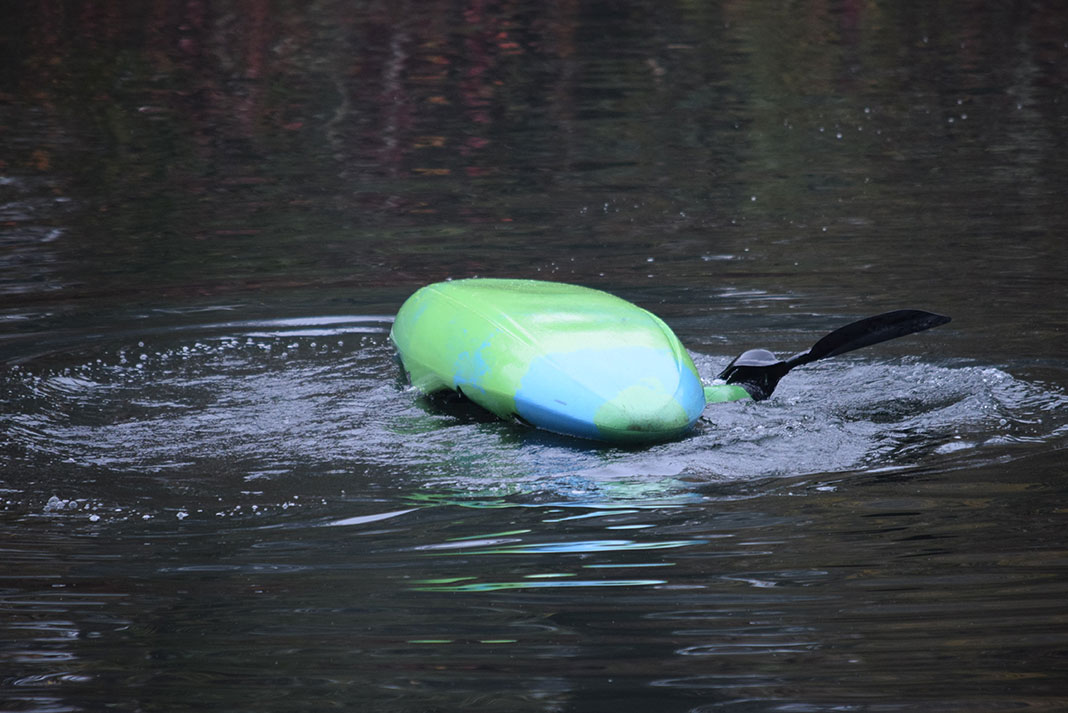Years ago, a buddy and I tied a couple of borrowed kayaks to his car and headed to the lake. Our mission was simple: we were going to learn to roll. We even had a book that was going to teach us how. We studied the crude line drawings, barely bothering to scan the accompanying text. Being natural athletes and confident of mastering such an easy trick, we were sure that our kayak roll wouldn’t require any real troubleshooting. I remember that our main strategy was to throw ourselves into the water with maximum force in order to generate the momentum necessary to get back upright again on the opposite side.
We failed to roll even once.
In our defense, at the time it was just about unheard of to be able to roll (at least in our circles). In fact, I don’t think that I had ever even seen the maneuver successfully performed—there were rumors, but no confirmed sightings.
Now, with the benefit of hindsight and many successful (and a few less successful) rolls behind me, it’s time to present a few hints about the often elusive art of rolling.
12 tips for troubleshooting your kayak roll
1 Don’t beat yourself up
Don’t beat yourself up if you’re not immediately successful. Most paddlers need more than one or two lessons. Be kind to yourself.
- Most paddlers need more than one or two lessons. Be kind to yourself. | Photo: Jennifer Uppendahl/Unsplash
- Don’t beat yourself up if you’re not immediately successful troubleshooting your kayak roll. | Feature photo: Jennifer Uppendahl/Unsplash
2 Make sure your boat fits you
Do make sure your boat fits you. If you are so loose that you can’t achieve a solid grip on the boat with your lower body, you will not be able to roll.
3 Work on your hip flick
Don’t forget to really work on your hip flick. A great drill is to grab the side of the pool or a dock or the bow of someone else’s boat, lay your head down on the pool’s edge and practice rolling your boat upside down and then upright again, using only your lower body and not your arms. Keep your head down.
4 Find a buddy
Do have a buddy stand in the water beside your boat, and have them guide your paddle through the proper motion.
5 Watch your blade
Don’t let your blade dive during a roll. Maintain a climbing angle on your active blade. Use goggles or a mask to watch your blade.
6 Get your buddy to spot you with a rescue
Do get your buddy to spot you with a rescue. This way, instead of having to swim, you can simply grab her bow and pull yourself upright if you blow your roll.
7 Don’t bring your head up first
Don’t bring your head up first. Duct tape your head to your shoulder, bite the sleeve of your jacket or use any other means to ensure your head comes up last.
8 Don’t be rigid
Strive to be supple and flowing, don’t be rigid or depend on power.
9 Practice a dryland roll
Do practice a dryland roll by sitting in your kayak and going through the motions in the backyard—this is a great drill helping your body learn the motions through repetition.
10 Use a paddle float
Do make rolling easier by using a paddle float on your active blade. But don’t get stuck at this stage—ditch the float once your body has learned the motions.
11 Wear nose plugs
Do wear nose plugs to prevent water rushing up your nose. You’ll have an easier time concentrating on the motions, and avoid the dreaded post-rolling-session nasal drain, which for some reason usually happens during a meal.
12 One-on-one instruction
YouTube is great, but one-on-one instruction is better.
This article originally appeared in Adventure Kayak, Early Summer 2007 and in Paddling Magazine Issue 65. Subscribe to Paddling Magazine’s print and digital editions here, or download the Paddling Magazine app and browse the digital archives here.
Don’t beat yourself up if you’re not immediately successful troubleshooting your kayak roll. | Feature photo: Jennifer Uppendahl/Unsplash

In my youth I had a trampoline. A trick we called a “swivel hip” is the most helpful skill I took from trampoline to kayak rolling. A “swivel hip” has you do a sit and in the air you rotate to sit the opposite direction. It’s all in the hips. Likewise, a kayak roll is all in the hips.